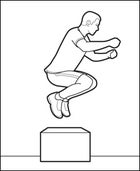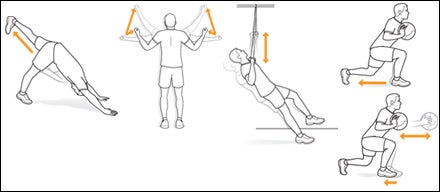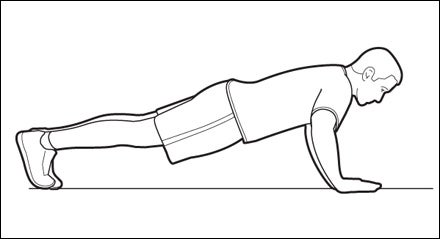Build Power, Not Bulk
The Pillars of Fitness
To get in peak shape try out all four parts of our comprehensive series.IF YOU’VE BEEN FOLLOWING our Pillars of Fitness series (“Building a Base,” March, and “Speed Up,” May), congratulations. By now you’ve dedicated yourself to sustainable, year-round conditioning and pushed yourself harder in pursuit of your summertime endurance goals. As the dingos say, good on ya, mate.
Now, with the cooler, shorter days of autumn approaching, and your long summer runs and rides coming to an end, it’s time to rebuild the muscle mass that atrophied while you focused on endurance. Here’s why: As any contestant on America’s Gargantuan Loser could tell you, lean muscle burns more energy. You’ll keep the weight off easier this fall and winter if you remember that. More important, as the seasons change, so do your athletic needs. That 50-mile bike ride won’t be much help when you need to hold an icy edge on the steeps at Killington. Fall soccer, skiing and snowboarding, surfing vacations, drunken pond hockey they all demand strength that an exclusive cardio routine won’t give you.
The good news? Building real strength no longer means paying membership fees and standing in line for a sweaty Nautilus machine glistening with staph bacteria. This month, our experts have designed a mobile strength routine envision the athletic form of Jackie Robinson, not the ‘roided-up Barry Bonds that challenges your balance more than your biceps and delivers total-body power. All you need are a few simple pieces of equipment (see “Create Your Own Fitness Center,” opposite) and a couple of hours a week. It’s time to awaken your dormant athleticism.
Meet the Experts
NANNA L. MEYER: A doctor of exercise physiology with the University of Colorado at Colorado Springs, Meyer serves as the sports dietitian for U.S. Speed Skating. This month she provides dietary guidelines for strength training.
ERIC MINKWITZ: A former professional football player, Minkwitz is an independent sports-performance trainer who’s conditioned hundreds of athletes, employing a range of mobile-strength moves that don’t require complex equipment or expensive gyms.
PER LUNDSTAM: As the strength-and-conditioning coach for the U.S. Ski Team, Lundstam has helped oversee the team’s transition from “correlative” strength training (building bigger quads and glutes to theoretically improve skiing power) to “supportive” strength training (strengthening the core and muscles that actually improve skiing) and its current emphasis on mobile strength training.
Step 1: Skip the Gym
Your favorite machines and lifts are designed to destroy you. I'm a walking test case.
CREATE YOUR OWN FITNESS CENTER
Five months of health-club dues buys all the mobile-strength-training equipment you’ll ever need. This will get you going.1. FLEXBANDS: These inexpensive bands replace the complicated cable systems at the club and add resistance to hundreds of moves. $10$30;
2. DOUBLE-GRIP HANDLE BALLS: Most medicine balls don’t help hand and forearm strength. These do. $40$55;
3. TNT POWER CABLES: Better than the flexbands (above) for rows and pulldowns, these cables can go with you on trips. $35;
…
Strength

In high school, I lifted weights at a meat locker of a gym in the X: the run-down, tattoo-parlor-and-dollar-movie section of Springfield, Massachusetts. The gym, Big Daddy’s, had recently produced 1983’s Mr. Universe, Jeff King. Just about every thumb breaker in the greater Springfield area chalked up and grunted at the place.
Big Daddy’s was my introduction to strength training. In theory, I was there to get stronger for sports, but recreational power lifting became a sport in itself. I favored bench press above all. Then seated military presses, seated leg presses, and seated preacher curls. By my freshman year of college, I could bench 310 poundstwice my body weightand military-press 225 pounds behind my head a couple dozen times.
What I didn’t know then was that my favorite machines and free-weight lifts were destroying me. Those contraptions and benches are designed to isolate and supersize muscles. But isolation is the enemy. Every sport we do as outdoor athletes demands that the full body participate. You don’t biceps-curl your way up an ice climb or bench-press your way down a river.
“When we first start to move as babies, we learn to coordinate everything together in basic movement patterns,” says Lee Burton, director of athletic training at Averett University and a pioneer of the mobility-before-strength movement. “But isolating moves like leg presses and knee extensions don’t communicate enough with the rest of the body. This creates asymmetries that set you up for injury, and that disrupts the entire body.”
Here’s what all that anti-mobile lifting got me: During a frigid mogul-skiing contest in New Hampshire, my left humerus squirmed from its cozy socket on a misplaced pole plant. I credit the shoulder injury to the military presses, which, with their extreme range of motion, stretch and degrade the ligaments that are intended to hold your shoulder in place. Shortly thereafter, I herniated a disk in my lower back, a condition that had me nearly crippled for most of my twenties. Thank you, bench press, which makes your lower back weak relative to your chest, arms, and shoulders. Much later I would blow an ACL skiing powder in Canada. Didn’t even fall. My quads simply overpowered my hamstrings in a turn and pop! Blame the seated leg press.
The worst part? All those exercises failed to make me stronger in a useful way. Michol Dalcourt, a longtime professional hockey trainer in Canada, witnessed this dynamic firsthand when he compared the performance of seasoned pros, placed on machine-dependent workouts, with rookie skaters just off the farm. “Ask a farm kid what they do and it’s ‘Chores,’ ” says Dalcourt. “Moving stuff. Shoveling. The body is stronger as a whole than the sum of its parts. They never set foot in the gym, but they were stronger.”
A 2008 study in the Journal of Strength and Conditioning Research validates that anecdotal evidence. In the study, one group of participants worked out for 16 weeks on machines with fixed ranges of motion, while the other group used free-form weighted cables. The result? The fixed-machine group increased strength by 57 percent, while the free-form group increased by 115 percent. But even more telling, the free-form group’s balance improved a staggering 245 percent, compared with 49 percent for the fixed group.
Which brings us to the state of the art in strength training. Mobile strength means training the body to produce power in an endless range of real-world movements to build supple and flexible muscles in sync with the kinetic chain (i.e., your entire body). It’s the natural evolution of the functional-strength movement, and some refer to it as “usable” strength training. Whether you brand it farm-boy strength or mobile strength, it’s based on the notion that the only strength that matters is the strength you use. Because you can’t pump iron at Big Daddy’s forever.
Step 2: Eat for Strength
Lifting on empty does more harm than good. Here's how to fuel up for your next workout.
BEFORE For endurance, it’s best to eat carbs two or three hours before exercise; for strength training, you’ll need a mix of protein and carbs 30 minutes to an hour beforehand. Muscles need amino acids and glycogen for energy and to limit the damage you’re doing under load. “Strength training in a fasted state will have a negative effect on muscle regeneration,” says Meyer. “Six grams of proteinone egg, a glass of milk, or a cup of yogurtis probably enough, but 10 to 15 grams is ideal. More protein than that would slow down the digestive process.” As for carbs, 30 grams will do. That’s what’s in most exercise bars or a small bowl of cereal.
DURING Water is fine unless you foolishly skipped that pre-workout meal, in which case a sports drink with a mix of carbs and protein should get you through.
AFTER As with endurance recovery, the first 30 minutes after strength training are crucial, but don’t go overboard with heavy shakes loaded with 50 grams of protein. “More is not better with protein,” says Meyer. “It seems that repeated, smaller amounts is more effective. This lets the muscle pick up the amino acids it needs without getting overloaded trying to clear out the extra.” What you ate before your workout (yogurt, chocolate milk, cereal) works here, too, but be sure to revert to your normal diet of lean proteins, veggies, and whole-grain carbs later.
Step 3: Build with Balance
Ditch the machines. These moves engage multiple muscle systems for real-world power.

POWER OUT OF THE GATE
Per Lundstam’s four keys to stronger skiing1. Look at strength training as a way to support your skiing, not as a goal in itself. “Instead of just trying to develop isolated strength, we develop the supportive components to build strength on skis,” says Lundstam. “There’s not much correlation between performance and the strength gains you make under a bar at the squat rack.”
2. Don’t let your baseline aerobic fitness slide. “Our athletes work year-round on stationary bikes. That aerobic efficiency lets them recover quickly. And when they’re tired or injured from racing, we can train on the bike for strength and explosiveness.”
3. Build muscle only where you need it. “We do body-shape analysis to gauge an athlete’s needs…
LOWER-BODY STRENGTH
STRETCH-BAND DEAD LIFTS
Standing on a stretch band with your feet hip width apart, reach down and grab the middle of the band with both hands in an overhand grip. With your hips high, your abs contracted, and your spine neutral (not arched or bowed), initiate the dead lift by driving your hips forward, keeping the band tight against your body through the full movement.
To finish, flex your glutes and squeeze your shoulder blades tight.
MEDICINE-BALL SQUAT AND THROW
With your feet at hip width, raise a medicine ball to your chest, keeping your spine in a neutral position. Now squat, bending your knees to 90 degrees while keeping them behind your toes, and rotate your torso so the ball is positioned over one quad. Driving forcefully out of the squat, throw the ball at a 45-degree angle up and away from your bodymaking sure the cat is safely out of the way first.
UNDERHAND MEDICINE-BALL THROWS
Again, stand with feet hip-width. Hold the medicine ball between your knees like you’re shooting a granny-style free throw. Tapping into the power of your hips, launch the ball at a 45-degree angle. (Bounce it off a wall for easy retrieval, or just lob it toward North Korea.)
DONKEY KICKS
Running and cycling favor quad strength over glute power. But in sports like skiing, glutes balance the load and provide explosiveness. Starting from a standing position, move into a downward-dog yoga stance, being sure to contract your abs as you do so. Lift one leg and slowly bring the knee toward your chest. Drive your heel back explosively with a strong glute contraction, like a kicking burro.
UPPER-BODY STRENGTH
PUSH-UPS PLUS
A cornerstone of the L.A.-based Sports Medicine Institute’s training programs, this modified push-up should forever replace your bench press. Set up in a push-up position with your hands slightly narrower than shoulder width. Descend toward the floor, squeezing your shoulder blades together, until your elbows reach a 90-degree angle. Press up and return to the straight-arm starting position. Now raise, or “wing,” your shoulder blades, and then, without bending your elbows, close them again. (To make it harder, string a light exercise band from hand to hand over your back.)
PRONE SHOULDER CIRCUIT
A few weeks of these shoulder circuits, from the Athletes’ Performance Institute in Tempe, Arizona, will hone your back and shoulders like no machine could. Lay prone on the ground, face down, and position your arms so you form the letter Y. Your thumbs should be pointing skyward. With your shoulder blades closed, move your arms to a T position before bending your elbows to form the letter W. Repeat.
STRETCH-BAND ROW
Here’s a homespun version of the low row favored by gym gorillas. The goal is not to build huge shoulders but to balance the strength gains of the push-up (left) by conditioning the upper back. Wrap a stretch band around a post or tree trunk, then sit upright on the ground. Level your chin, pull your abs in, and grasp the band with an underhand grip. Close your shoulder blades and row until your upper arms are vertical and the band meets your belly.
TORSO AND BALANCE MOVEMENTS
STRETCH-BAND SUPINE PULLS
Anchor a heavy stretch band over the top of a tree limb or pull-up bar and grasp the band with an overhand grip. Lean back so your body is at a 45-degree angle to the ground. Lift one foot a few inches, and dig in with the heel of the other. Now employ your upper-back muscles to “row” your chest toward the band.
CABLE CHOPS WITH BOSU
This exercise can be done with a cable machine or light exercise band anchored beneath a door. Stand sideways to the cable in a staggered squat, with your left leg a little forward and on top of a Bosu ball. Grasp the cable with both hands at hip level and initiate a chopping motion, from low left to high right.
The key is to contract your abs and stabilize your entire body throughout the motion. Hold the chop at chest level for five seconds and repeat.
KICK, SLIDE, PUNCH
Begin in a staggered squat, with your left foot set back somewhat and a medicine ball held at your chest like you’re about to pass a basketball. Keep your shoulder blades closed, elbows bent, and abs tight. To begin, quickly step back with your left foot and land on the ball of your foot. Keeping your chest square to your hips, and without twisting any joint (especially not your rear ankle or knee), slide your right foot partway back so your feet end up staggered again. At the same moment, punch the medicine ball forward with an explosive outward push, before pulling it back to your chest.
Mapping Your Workouts
Got the moves down? Here’s how to put them all together in a six-week program that will deliver results. Do one set of each exercise, following the recommended number of reps below. For resistance, pick medicine balls and stretch bands that leave you feeling worked by the final rep. To avoid soreness, make sure you train at least two days per week, but not more than three, and remember to rest after intense sessions.
Week 1
Focus: Strength Endurance
Reps: 1520
Goals: Using little to no weight and high repetitions, this phase builds your base and lets you focus on technique before intensity.
Week 2
Focus: Basic Strength Initiation
Reps: 810
Goals: Cut the frequency back to moderate and gently ramp up the weight and intensity. This preps the body for the harder weeks to come.
Week 3
Focus: Basic Strength
Reps: 46
Goals: Boost the intensity by adding incremental resistance while reducing reps. Incorporate the more complex exercises you’ve avoided.
Week 4
Focus: Strength Power
Reps: 35
Goals: This low-volume, high-intensity week encourages the type of stress that leads to peaking and generates usable power and speed for outdoor sports.
Week 5
Focus: Active Recovery
Reps: 0
Goals: Run, bike, play, and rededicate yourself to nutrition, stretching, and self-massage.
Week 6
Focus: Strength Endurance II
Reps: 1520
Goals: Revert to high reps and low intensity for maintenance. It should feel easy.


